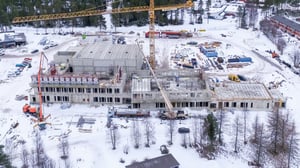
Pouring Concrete in Cold Conditions – Understanding and Overcoming Challenges
The Game-Changing Impact
Concreting in cold temperatures poses a variety of challenges that can not only affect construction progress, but also endanger the structural integrity of the building.
As temperatures drop, the curing process of concrete slows down considerably and with it the formwork times increase. At temperatures below -10 degrees, curing even comes to a complete standstill. This fact alone poses a considerable risk, as the premature freezing of young concrete can lead to structural damage. Large temperature differences in the component between the edge and core areas can lead to thermal shock and cracks in the concrete. There is also a risk of frost damage when concreting against frozen ground, formwork or construction elements. In cold temperatures, the bond between the concrete and the reinforcement is also reduced.
When concreting in winter, it is important to ensure that the concrete has reached frost resistance before the first drop in concrete temperature below zero degrees and that it has reached the required target strength before stripping the formwork.
Various local standards require different curing methods at cold temperatures to prevent damage. These include Winter concrete mixes, heating raw materials, covering exposed concrete surfaces, longer curing times, use of heated tents, heated formwork or other heat sources. This may leads to considerable additional costs and productivity losses.
Despite all these measures, one challenge remains unsolved: the current condition of the concrete in the formwork remains a black box.
This is where Vemaventuri sensors offer an innovative solution. By continuously measuring the concrete temperature, it can be monitored around the clock. This allows the temperature development to be tracked and documented. If necessary, measures can be initiated if the concrete temperature falls below the required values.
The development of the concrete strength can be monitored at the same time using a corresponding calibration curve. This allows the formwork to be stripped as early and safely as possible when the required target strength is reached. The strength development can be simulated with the forecasting tool, taking into account the expected temperatures. This enables early planning of measures on the construction site.
Concreting in cold temperatures poses numerous challenges, from delayed curing times to frost damage. The use of sensor technology, such as the TEMO Temperature and Maturity Monitoring from Vemaventuri, revolutionizes this process. Continuous monitoring not only enables early detection of problems and automatic documentation, but also precise control of the curing process. This not only improves and safeguards the quality of the concrete, but also increases efficiency and minimises costs.
Discover how sensor technology solutions are shaping the future of concreting. Browse our website for more information and project examples and feel free to contact us for a quick demo.
Ready for Winter? Your Concrete Projects Can Be, Too.
Cold weather is coming! Will your construction site keep up? Discover how smart monitoring transforms winter challenges into opportunities for safer, faster, and more reliable concrete work.
Unlock the secrets behind the flyer:
- Prevent delays and rework
- Boost quality and compliance
- Make confident decisions, even in the cold


